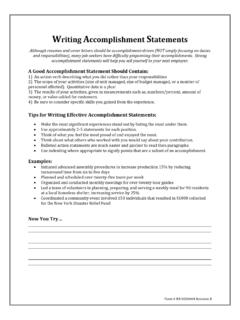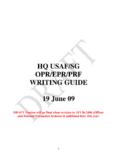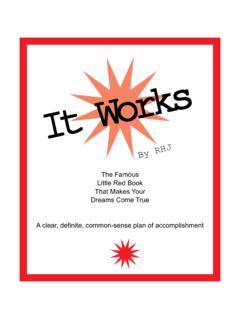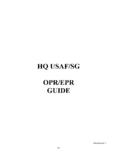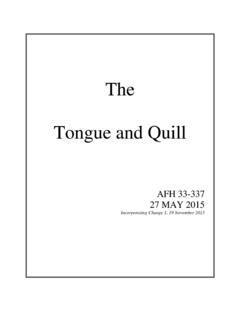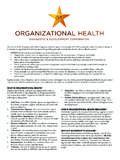Transcription of PREPARING RESUMES AND WRITING COVER …
1 PREPARING RESUMES AND WRITING COVER LETTERS I. UNDERSTAND THE POSITION The Job Requirements In order to target your resume and COVER letters, it is critical that you invest some time in understanding requirements of the position. Benefits Two critical benefits of better job understanding include: Time savings and reduced frustration that results from applying for jobs not suited to your strengths and aspirations. Improved ability to position yourself to meet the needs of the hiring manager. How to Better Understand the Position Analyze the Vacancy Announcement What are the responsibilities, competencies and skills required? Ask yourself: Do I meet the minimum qualifications? Do I have the skills, abilities or competencies for the position?
2 Do I have a thorough understanding of the job mandate specifications and the experience required? Why am I really interested in the position? Am I interested in the job for the right reasons? What do I know about the Department or Unit? Does it make sense for me to apply now? Does it fit in with my future career goals? What is the Hiring Manager looking for? Use your networking skills to ask/discuss what is critical for this position Ask/call the Hiring Manager to obtain further information. PREPARING RESUMES and WRITING COVER Letters Do an analysis of the position against your qualifications: This analysis will help you focus your application package, including your covering letter and resume , as well as help you prepare for a potential job interview; This analysis can also: Highlight the strengths you have for the position, as well as identify any gaps for future development.
3 II. PREPARING THE resume Section 1: Profile Statement Put simply, the profile statement is your introduction. It describes the primary value you can offer to the organization through the answers to two questions: 1. Who you are 2. What are your key skills and strengths The purpose is to give prospective hiring managers a quick, high-level, idea of who you are (professionally!) and what you can do for them. Sample Profile Statements: Experienced professional with key strengths in facilities management and team leadership. Accomplishments in volunteer coordination, training, and procurement. Motivated, analytical thinker with effective communication skills. A motivated, energetic and outgoing individual with strengths in training, counseling and team management.
4 Focused on bottom-line, well-organized and action-oriented problem solver who thrives on innovative challenges. Excellent interpersonal skills in a variety of working environments, including public service and research organizations. In the past, RESUMES usually included an objective statement at the beginning. It was a way of summarizing the type of position you are seeking. The advantage of a profile statement over an objective statement is that it gives the opportunity to position yourself for the job more precisely. Put it this way: if you had 20 seconds with the director of the unit or department where you were applying, PREPARING RESUMES and WRITING COVER Letters would you spend it telling him/her what you want, or would you try to highlight your skills and experience?
5 Think of your profile statement, then, as those 20 seconds with the director. Section 2: Career History and Accomplishments This section is the main body of your resume , demonstrating how you used your skills to achieve results and make positive contributions. Use the Skills Assessment to build key skills phrases and outline your accomplishments. The two styles that are discussed most often are the chronological format functional format. Both have their own advantage and disadvantages when it comes to presenting your information. A third style, the combination, is a compromise between the two and has become more popular in recent years. First here is an overview of the three formats. Then, on the next three pages, you can find abridged samples of the three formats.
6 Chronological This is the most common resume style, and generally the easiest to write. In the chronological format, the emphasis is placed on employment experience. The applicant's job history is presented in reverse chronological order, with the most recent jobs placed at the top of the list. Functional In this non-linear format your skills and achievements are emphasized Your employment history is summarized or avoided all together. Your skills and previous relevant experience (including educational experience) are presented at the beginning of your resume . They are organized so the employer can see how your skills relate to the job position you are applying for. It may take more effort to write a functional resume , but you are free to highlight your talents instead of your recent job experience.
7 Combination The combination resume is simply a functional resume with a brief employment history added. Skills and accomplishments are still listed first; the employment history follows. You need to reveal where you worked, when you worked, and what your job position was. While most employers might still prefer a chronological resume , this is a good alternative to the functional resume . PREPARING RESUMES and WRITING COVER Letters Section 3: Education This section is used to profile and highlight your education in terms of completed degrees, diplomas, certificates, or any of the above that are still in progress. Also include any evening programs that you are enrolled in. In other words, you are answering the primary question: What academic qualifications do you have that are related to the position?
8 Section 4: Professional and Personal Development This section is used to highlight any courses, workshops or seminars you have successfully completed to upgrade your skills and knowledge that are relevant to your career. In other words, you are answering the question: What have you done lately to improve and expand your skill set? III. WRITING THE COVER LETTER A COVER letter is a personal introduction that accompanies your resume ; as such, it should augment your resume in a more personal manner. As a rule, the more personal your COVER letter is, the better. Think of your COVER letter as an opportunity to distinguish yourself from other job seekers, by highlighting what makes you a unique applicant. Your COVER letter also plays a critical role in creating a hiring manager s sense of you as a person.
9 Use the COVER letter to convey more fully who you are than your resume . Go into detail about your background instead of reiterating information on your resume . Remember, your COVER letter provides a sample of your WRITING to a perspective employer. Your COVER letter should be kept to one page, personalized to an individual whenever possible, including his or her title (avoid To whom it may concern, if possible), and always for a specific organization. Your introduction should indicate how you came to apply for the position such as: Responding to a posting Referred by Jane Smith in Department Y. Next, summarize your qualifications related to the position for which you are applying. It is important to address: your qualifications as they relate to the requirements of the position, if known, such as with an advertised position.
10 Amplify or augment information contained in your resume , do not merely PREPARING RESUMES and WRITING COVER Letters repeat it. Include a few strengths or personal qualities related to the type of position you are pursuing. End with an action appropriate to the contact. For example, if you are responding to an unadvertised position, indicate you will follow up in a few days. If you are responding to an advertised position, indicate you are looking forward to the opportunity to meet or talk further. If it is an advertised position you should still follow up in a few days unless instructed not to, however, it may be better not to state this in your letter. It is important to balance the tone of your COVER letter.










